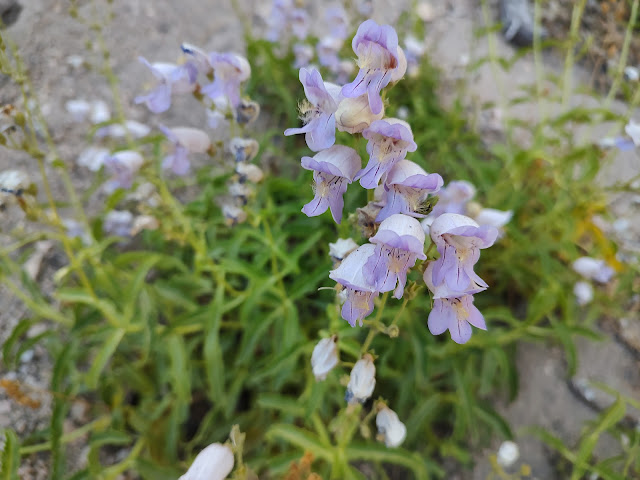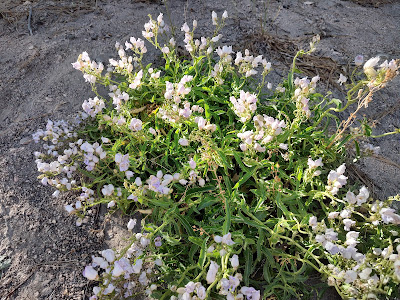
Grinnell

|
|
's beardtongue is a California native that loves dry summer weather. (Photos: Debbie Arrington) |
By Debbie Arrington
Some of the most colorful water-wise choices for California summer gardens are plants that grow here naturally: California natives.
My favorite right now is making a violet splash throughout the mountains in the southern half of our state, but it’s just as at home in dusty Sacramento.
It’s ’s beardtongue, a pretty penstemon that lives up to its reputation as a summer snapdragon. Bees and hummingbirds love this wildflower with its striped throat and pleasant scent. It’s perfect in rock gardens or other places that need a burst of bright color. Tolerant of full sun, it loves a spot with a little afternoon shade – as long as it has excellent drainage.
With 2-foot flower spikes above low-growing foliage, ’s beardtongue (
Penstemon grinnellii
) – also known as the southern woodland penstemon – is native to pine and oak forests in the foothills and mountains from the southern Sierra down to the San Bernardino National Forest, where our family owns a cabin. The hills around our place are dotted with these eye-catching flowers, which keep blooming for several weeks with no summer irrigation (although it appreciates an occasional July shower).
This deep-rooted perennial gets almost all the water it needs in winter and spring. Even after a bone-dry start to 2022, these drought-tolerant natives have thrived. They’ve bloomed profusely for more than six weeks so far and show no signs of letting up.
In a suburban landscape, ’s beardtongue is an excellent companion to members of the sage family. Both like life on the dry side, need good drainage and attract lots of pollinators.
In the wild, it’s found from 800 to 9,000 feet in elevation. As long as it’s not babied, this penstemon can adapt to the valley, too.
Here’s how native-plant specialist
Las Pilitas Nursery
describes ’s beardtongue:
“A very showy rock garden plant. Needs perfect drainage, will survive in clay as long as planted on a slope and not watered in the summer. Do not even try in a wet summer climate. The flowers look pretty enough to eat (I don't think they’d kill you) and are worth growing just to shock your neighbors. … Plant them all in a garden with
sages
and you'll have a wild place full of color and life. You'll also have fits figuring out what is what.”
It will live in soils from “almost gravel to almost cement,” says Las Pilitas, which is one of several nurseries that usually stock this perennial.
For more on this penstemon and where to find it for your garden:
https://bit.ly/3uL9ioU
.

|
|
's beardtongue is a low-growing perennial with 2-foot flower spikes.
|
Comments
0 comments have been posted.Sacramento Digs Gardening to your inbox.
Food in My Back Yard Series
April 22: Should you stock up on fertilizer? (Yes!)
April 15: Grow culinary herbs in containers
April 8: When to plant summer vegetables
April 1: Don't be fooled by these garden myths
March 25: Fertilizer tips: How to 'feed' your vegetables for healthy growth
March 18: Time to give vegetable seedlings some more space
March 11: Ways to win the fight against weeds
March 4: Potatoes from the garden
Feb. 25: Plant a fruit tree now -- for later
Feb. 18: How to squeeze more food into less space
Feb. 11: When to plant? Consider staggering your transplants
Feb. 4: Starting in seed starting
Sites We Like
Garden Checklist for week of April 27
Once the clouds clear, get to work. Spring growth is in high gear.
* Set out tomato, pepper and eggplant transplants.
* From seed, plant beans, beets, cantaloupes, carrots, corn, cucumbers, melons, pumpkins, radishes and squash. Plant onion sets.
* In the flower garden, plant seeds for asters, cosmos, celosia, marigolds, salvia, sunflowers and zinnias. Transplant petunias, zinnias, geraniums and other summer bloomers.
* Plant perennials and dahlia tubers for summer bloom. Late April is about the last chance to plant summer bulbs, such as gladiolus and tuberous begonias.
* Transplant lettuce and cabbage seedlings.
* Weed, weed, weed! Don’t let unwanted plants go to seed.
* April is the last chance to plant citrus trees such as dwarf orange, lemon and kumquat. These trees also look good in landscaping and provide fresh fruit in winter.
* Feed citrus trees with a low dose of balanced fertilizer (such as 10-10-10) during bloom to help set fruit. Keep an eye out for ants.
* Apply slow-release fertilizer to the lawn.
* Thoroughly clean debris from the bottom of outdoor ponds or fountains.
* Start thinning fruit that's formed on apple and stone fruit trees -- you'll get larger fruit at harvest (and avoid limb breakage) if some is thinned now. The UC recommendation is to thin fruit when it is about 3/4 of an inch in diameter. Peaches and nectarines should be thinned to about 6 inches apart; smaller fruit such as plums and pluots can be about 4 inches apart. Apricots can be left at 3 inches apart. Apples and pears should be thinned to one fruit per cluster of flowers, 6 to 8 inches apart.
* Azaleas and camellias looking a little yellow? If leaves are turning yellow between the veins, give them a boost with chelated iron.
* Trim dead flowers but not leaves from spring-flowering bulbs such as daffodils and tulips. Those leaves gather energy to create next year's flowers. Also, give the bulbs a fertilizer boost after bloom.
* Pinch chrysanthemums back to 12 inches for fall flowers. Cut old stems to the ground.
* Mulch around plants to conserve moisture and control weeds.